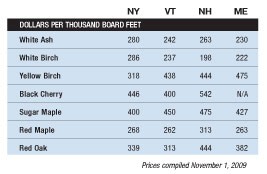These prices are for #1 hardwood logs, at least 8 feet long, with three clear faces and a minimum 12-inch top diameter. In the timber world, this is a log of average quality, not a prime sawlog and not a poor one.
Landowners should remember that the dollar amount here indicates what is being paid for logs that have been felled, limbed, skidded, bucked, and delivered to a mill or buyer. The cost of logging and trucking need to be subtracted from these figures to arrive at the price paid to the landowner. Because every job is different, these costs vary widely.
Negotiating a fair price requires an understanding of markets and job conditions. It’s recommended that landowners without this knowledge use a forester as an agent. A forester’s fee will add to the cost, but their representation will often result in a higher payment for the timber.
For decades, the most valuable Northeastern hardwood logs have been cherry, sugar maple, and red oak, with the order shifting among the “big three.” But now there’s a new kid on the block: yellow birch.
As recently as 2006, yellow birch logs were fetching prices less than 50 percent of either cherry or sugar maple logs. By this past autumn, they were up to 88 percent of both cherry and maple. Even more spectacular has been yellow birch’s progress against red oak: 60 percent in 2005 to 104 percent today. You may have missed it in the market turmoil, but yellow birch has knocked off red oak to join the “big three.”
Or perhaps more accurately, it’s the “medium four,” since all four species are bunched closely together in price and because that price is a pale reflection of what cherry and sugar maple were earning earlier in the decade. It isn’t that yellow birch has become more valuable; it’s that the other three have become so much less so.
Which isn’t to knock yellow birch at all: it’s the only hardwood we track that is worth more today (in constant dollars) than it was back in 2001, despite the recent recession.
These data are compiled from interviews with suppliers and buyers, and from the most recent print and on-line versions of the Sawlog Bulletin and used by permission. Please note that many of these prices were reported three months prior to our publication date, and current prices could be higher or lower.




Discussion *